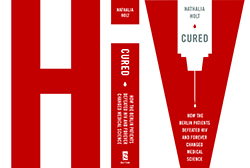HSU alum Nathalia Holt (’02, Biology) answers those questions in her forthcoming book by Penguin, “Cured: How the Berlin Patients Defeated HIV and Forever Changed Medical Science.”
Holt draws on interviews with patients, doctors and her own experience as an award-winning HIV researcher to examine the stories and lasting impact of the “Berlin patients” who were famously cured of HIV in 1996 and 2008.

“One of the most common things I hear from my HIV-patients is ‘I’ve heard of the ‘Berlin patients’ so does this mean a cure is coming to me?” says Holt, a research scientist at the Ragon Institute in Boston.
In “Cured,” Holt explores the cases of German-born Christian Hahn, who was cured of HIV in 1996 with early drug therapy and an experimental cancer drug, and American Timothy Brown, who was cured in 2008 with a stem-cell transplant. Both men are still HIV-free.
Brown, the more famous of the two “Berlin patients,” received a transplant to treat leukemia related to his HIV in 2007. In doing so, doctors gave him an entirely new immune system that was resistant to the virus.
Brown’s donor had a unique gene mutation—called CCR5-delta32—that protects a small number of people from HIV. The gene combination responsible for complete immunity is present in about 1 percent of Caucasians.

“This gene is pretty much the appendix of human proteins,” explains Holt, whose current work focuses on the gene. Previously, she used human stem cells to emulate natural HIV resistance in mice at the University of Southern California. That research is now in clinical trials.
In the years since Brown and Hahn’s groundbreaking news, other promising stories have followed. Just last year, a baby born with HIV in Mississippi was “functionally” cured after receiving aggressive treatment and now shows no symptoms of the virus. Not long after, French researchers announced that 14 patients treated with antiviral medications were able to control their HIV symptoms after stopping treatment.
“Cured” examines what those stories and others mean for the future of HIV treatment.
“What’s most fascinating to me from all of this that the ‘Berlin patients’ were cured by physicians who didn’t come from big research labs or clinical trials,” says Holt. “They passionately wanted to help their patients and did something radical that ended up working.”
“Their work has gotten people to pursue new strategies for luring HIV out of cells,” Holt adds. “It’s gotten a lot of people talking about a cure and that’s what’s so exciting.”
“Cured” will be released by Penguin in February. For more information, visit nathaliaholt.com.